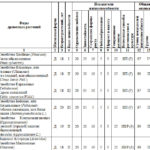
Prokopyeva Chr. O., Konyushkova M. V., Novikova N. M., Sobolev I. V. DIGITAL PHYTOINDICATION OF SOIL SALINITY IN THE DESERT STEPPES (REPUBLIC OF KALMYKIA) // Arid ecosystems. 2021. V. 27. № 2 (87). P. 68-81 | PDF
On the territory of the Northern Sarpinsky lowland plain landscape area of the Caspian lowland in the zone of light chestnut soils soil-geobotanic studies were carried out to obtain new data which would allow to estimate the range of variation of soil salinity, which is characteristic for plant species and plant communities of the desert steppe of the Kalmykia Republic, and to calculate the digital models to indicate the degree of soil salinity according to geobotanical data. Along the 64meters-long transect with 1-m step, geobotanical sites, soil digs and wells up to 2 meters deep were laid. In soil samples, the salinity index was measured as pNa in an aqueous suspension (1:5). The results allowed us to determine the quantitative boundaries of soil salinity for 12 plant species and 7 plant communities for 3 depths (0-30, 0-50, 0-100 cm). In relation to soil salinity, three groups of plants were distinguished. The first group includes species confined to non-saline soils with a narrow range of salt content values. The second group has a wide range in terms of salinity and a preference to non-saline soils. The third group includes saline species (halophytes) confined to saline and highly saline soils. Of the 7 plant communities found, two (Stipa lessingiana + Festuca valesiaca + Artemisia lerchiana and Stipa lessingiana + Festuca valesiaca + Tanacetum achilleifolium) are distributed on non-saline soils up to a depth of 2 m; two others (Festuca valesiaca + Artemisia lerchiana + Tanacetum achilleifolium and Artemisia lerchiana + Tanacetum achilleifolium + Artemisia pauciflora) tend to non-saline soils within 0-50 cm, and three (Kochia prostrata + Artemisia pauciflora, Artemisia pauciflora and Poa bulbosa + Anabasis aphylla) are found only on saline soils from a depth of 25-50 cm. Based on data on the presence of plant species as predictors, the CART (decision tree) method predicted the degree of soil salinity with an accuracy of 80% for the 0-30 cm layer, 81% for the 0-50 cm layer, and 64% 0 for the 0-100 cm layer. Significant predictor plants (rank>60) were Kochia prostrata, Tanacetum achilleifolium, Artemisia austriaca, and Festuca valesiaca. Other species have low values of importance (reliability) as predictors.
Keywords: soil salinization, phytoindication, plant species and community, indicators of depth and degree of salinization, importance, reliability, CART and Random forest algorithms, machine learning, communication models, accuracy of indication.
DOI: 10.24411/1993-3916-2021-10152











